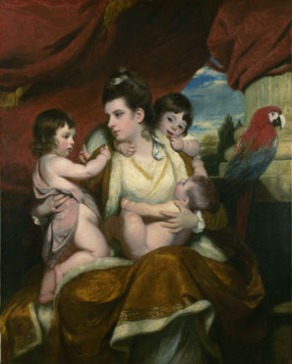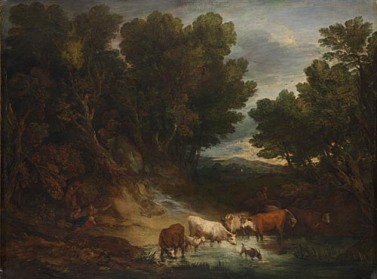1. Reynolds– In this depiction of Lady Cockburn, the woman is represented as a goddess, as more heavenly than the average person. the clothes she is wearing are regal, clean, white, and made of expensive furs, showing her wealth. In a similar light, her skin is fair and unblemished to show how much she stayed inside from no need to labor outdoors for her money. it is often compared to Van Dyck’s “Charity”, due to their clear similarities. however, Van Dyck’s seemed to have religious connotations behind it while Reynold’s’ was just a portrait. But Reynolds benefitted from this connection because Van Dyck’s was so loved.
The piece is very traditionally composed, with lots of balance from the leaning child, the mother’s neck, and the macaw. the dark drapery in the background puts the focus on the center of the piece, the mother and her children. The strokes and clean and smooth, making for a very classic and put together appearence.
2. Gainsborough– Known for having movement and freedom in his brushstrokes, Gainsborough’s pieces are much different than works such as Reynolds. The people portrayed are fashionable and recognizable. He uses dark colours and the absence of light. As portrayed in The Watering Hole, as well as his other landscapes, the scene is kept very calm and relaxed despite work being depicted.
People can be seen in this painting, though they generally blend into the background rather than being the focal point. The time of day cannot be determined. In comparison, The Watering Hole by his competitor Rueben is much more spread out with more movement, implying work and a hectic aura. Both works use the same colour scheme, though Gainsborough remains consistent by choosing dark colours.
3. Turner– Turner became known as “the painter of light” due to his use of vibrant colours and the sun as his main focal point. He sets his perspective with the sun and the sun beams. The accurate placement of his lighting and shadows makes his paintings appear realistic, as well as showing balance. These techniques that Turner made use of are a reflection of his idol Claude’s.

Turner’s depiction of “Ulysses Deriding Polyphemus” uses this same focus upon the emerging light from the bottom rightmost corner. The beams are showcasing the victor in the mid-left in comparison to the darker ship and rocks surrounding it. He also utilizes abstract figures coming from the sea by the bottom of the ship, an interesting factor to his technique.
4. Constable– During his time, Constable was not very appreciated amongst the English. He made use of a lot of texture and big fluid strokes. Compared to Turner’s landscapes, Constable’s art is much darker with no use of sun, making it stand out against the normal landscapes of that time.

Constable’s “Salisbury Cathedral” is very small and condensed compared to typical landscapes of this time period. This makes the artwork appear heavy and darker. He uses no big fluid strokes, but small thick ones instead. This creates texture, especially in the trees, again making him stand out against other landscape artists of his time.


